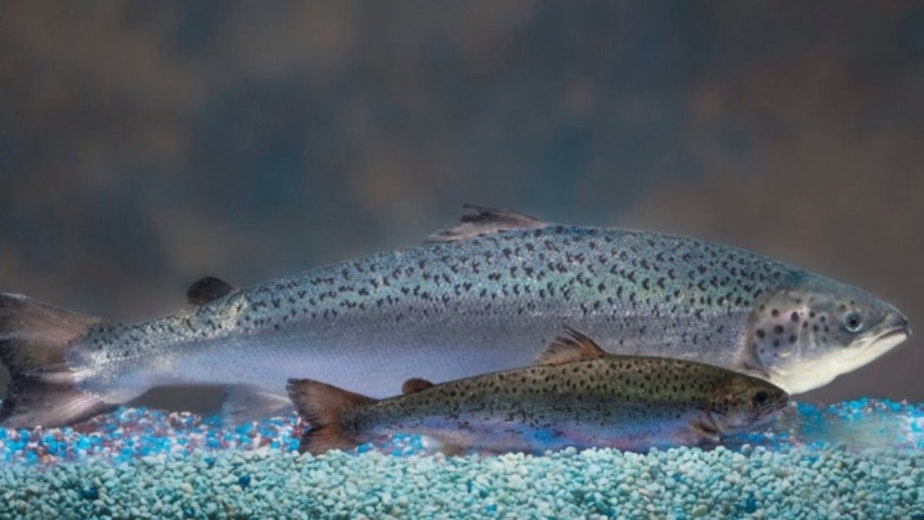Genetically Engineered Salmon Swim Closer To Store Shelves, Concerning Tribes And Food Groups

Genetically engineered salmon are one step closer to winding up on store shelves, after the U.S. Food and Drug Administration lifted an import ban.
It’s a move that’s concerning to tribes, food groups and environmentalists.
The new guidelines don’t require labeling the fish as “genetically engineered,” rather the labels will read “bioengineered.” The term is a little less loaded, said Amy van Saun, a staff attorney for the Center for Food Safety.
“It might be a symbol that says ‘BE’ or it might even be a QR code that you have to actually scan with a smart phone in order to get more information to find out if it’s genetically engineered,” van Saun said. “So it’s quite a bit more burdensome. It doesn’t really give people the information on whether or not the fish is genetically engineered when they look at it in the grocery store.”
The FDA will now allow AquaBounty to import its AquaAdvantage Salmon eggs to a land-based facility in Indiana, where the salmon can be grown for food.
Sponsored
The salmon have been genetically engineered to grow faster than farm-raised Atlantic salmon. The FDA first approved genetically engineered salmon as safe to eat in 2015. This was the first time the administration had approved a genetically engineered animal for human consumption.
On its website, AquaBounty says all its eggs produce sterile females “making it impossible for them to breed among themselves and with other salmon. In addition, FDA approval requires them to be grown in physically contained land-based systems, further reducing any potential impact on wild populations.”
According to an FDA fact sheet, “The salmon are safe to eat, the introduced DNA is safe for the fish itself, and the salmon meet the sponsor’s claim about faster growth.”
Congress held off the FDA’s ruling until guidelines were in place that would label the fish as genetically engineered.
The Center for Food Safety argues a “bio-engineered” label does not meet those guidelines.
Sponsored
Groups have raised concerns over the environmental harm they say genetically engineered salmon could cause.
“Farmed fish escape. Even though they’re in these land-based facilities (in Indiana), there’s still potential for escape,” van Saun said. “Once we have these novel, new types of organisms out there, there’s no way to call them back.”
Van Saun said the fish could compete with native salmon for food and resources. They could prey on native salmon. Or they could interbreed and cause genetic changes in wild salmon.
“What concerns us the most is potential expansion into net pen aquaculture in the ocean, which is how it’s done. There will definitely be escapes if that ever happens,” van Saun said.
Northwest tribes said the FDA did not consult with them about concerns with genetically engineered salmon.
Sponsored
“The FDA’s unilateral decision, without tribal consultation, is an alarming signal that our sacred and prized wild salmon is now even more vulnerable to external markets and ecological threats,” said Fawn Sharp, president of the Quinault Indian Nation, in a statement. “It’s unconscionable and arrogant to think man can improve upon our Creator’s perfection in wild salmon as a justification and excuse to satisfy corporate ambition and greed.”
Valerie Segrest, a Muckleshoot tribal member and executive director of Feed Seven Generations, said this move “has directly attacked the life ways of Pacific Northwest Tribal communities.”
“Clearly this is an appropriation of our culture and this action will lead to inevitable contamination and irreversible damage to our food system,” Segrest said in a statement.
The Center for Food Safety’s Amy van Saun said the group is considering a lawsuit to “force the FDA to comply” with genetically engineered labeling rules set by Congress. The group is already challenging the FDA’s approval of genetically engineered salmon for consumption. Van Saun expects a decision on that lawsuit by the end of this year.
Related Stories: [Copyright 2019 Northwest Public Broadcasting]
